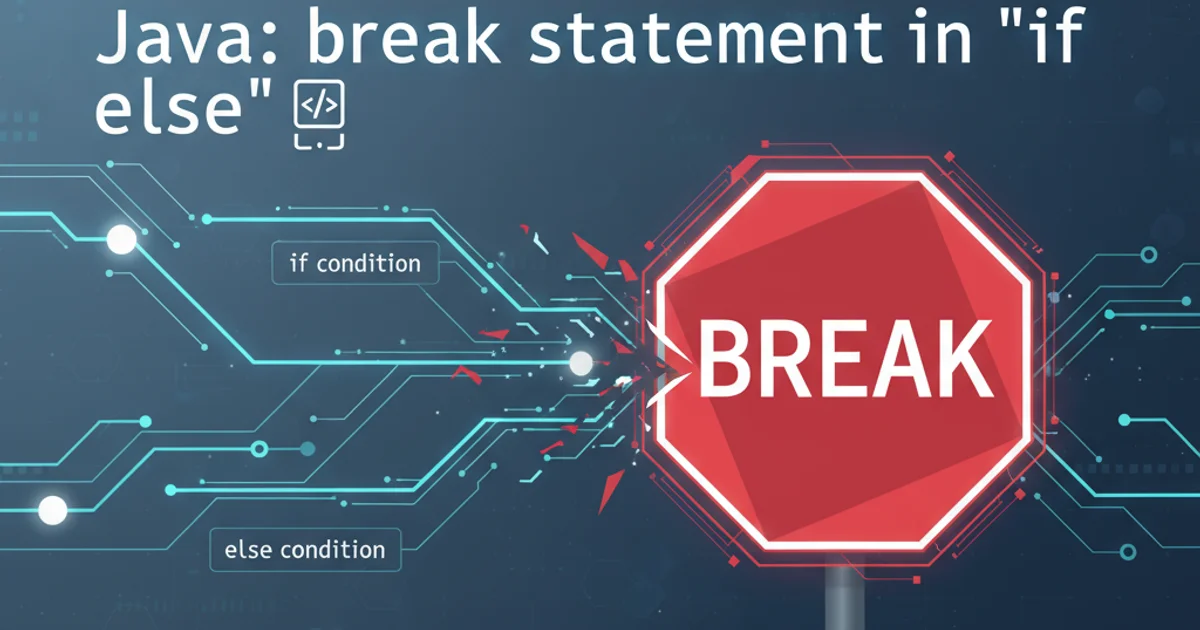Java: break statement in "if else"
Categories:
Mastering the break Statement in Java if-else Constructs

Explore the nuances of using the break statement within if-else blocks in Java, understanding its scope and common pitfalls, especially in loops.
The break statement in Java is primarily associated with terminating loops (for, while, do-while) or switch statements. However, its direct use within a standalone if-else block, outside of these looping or switching constructs, is a common point of confusion for many developers. This article clarifies when and how break can be effectively used in conjunction with if-else conditions, emphasizing its role in controlling program flow within iterative structures.
Understanding break Scope in Java
The break statement is designed to exit the innermost enclosing switch statement or loop (for, while, do-while). It does not have the capability to terminate an if statement itself, as if statements are not iterative or selection constructs that break is designed to exit. Therefore, an if statement containing a break must always be nested within a loop or a switch statement for the break to be syntactically valid and functionally meaningful.
flowchart TD
A[Start Program] --> B{Is 'break' inside a Loop or Switch?}
B -- Yes --> C[Execute Loop/Switch]
C --> D{Condition Met in 'if'?}
D -- Yes --> E[Execute 'break']
E --> F[Exit Loop/Switch]
F --> G[Continue Program After Loop/Switch]
B -- No --> H[Compile-time Error: 'break' outside loop or switch]
H --> I[End Program (Error)]Flowchart illustrating the valid scope of the break statement in Java.
Using break with if-else Inside a Loop
The most common and correct scenario for using break in conjunction with if-else is when the if-else block is nested within a loop. In this setup, the if condition determines whether the loop should be terminated prematurely. The break statement, when executed, will immediately exit the enclosing loop, and program execution will resume at the statement immediately following the loop.
public class BreakInLoopExample {
public static void main(String[] args) {
for (int i = 0; i < 10; i++) {
System.out.println("Current iteration: " + i);
if (i == 5) {
System.out.println("Condition met: i is 5. Breaking out of the loop.");
break; // Exits the for loop
} else {
System.out.println("i is not 5. Continuing...");
}
}
System.out.println("Loop finished or broken.");
}
}
Example demonstrating break within an if-else inside a for loop.
break can make loop logic harder to follow if overused. Consider restructuring your loop conditions or using return from a method if the termination condition is complex or affects the entire method's execution.The Invalid Use Case: break in a Standalone if-else
Attempting to use break directly within an if-else block that is not enclosed by a loop or switch statement will result in a compile-time error. The Java compiler will report an error similar to "break outside switch or loop". This reinforces the rule that break must always have an enclosing iterative or selection construct to operate on.
public class InvalidBreakExample {
public static void main(String[] args) {
int x = 10;
if (x > 5) {
System.out.println("x is greater than 5.");
// break; // COMPILE-TIME ERROR: 'break' outside switch or loop
} else {
System.out.println("x is not greater than 5.");
}
System.out.println("Program continues.");
}
}
Illustrating the compile-time error when break is used outside its valid scope.
break statements are within a for, while, do-while loop, or a switch statement. Otherwise, your code will not compile.